html
Discover Yunnan by Train: A Complete Guide to Scenic Rail Travel
Embark on an unforgettable journey through Yunnan, China’s southwestern gem, where ancient traditions blend seamlessly with modern convenience. With the recent expansion of its railway network, Yunnan has become more accessible than ever, offering travelers a chance to explore its breathtaking landscapes, cultural gems, and iconic destinations via scenic rail travel.
1. Introduction to Yunnan’s New Railway Developments
Yunnan’s railway network has undergone significant transformations, making travel within the province and beyond a breeze. Two major routes have particularly caught the attention of travelers:
- The Chengdu-Jiuzhaigou Railway: Partially opened, this line promises to connect Chengdu to the UNESCO-listed Jiuzhaigou Valley, a paradise for nature lovers.
- The Lijiang-Shangri-La Railway (Lixiang Railway): Fully operational since November 26, 2023, this route has reduced travel time between Lijiang and Shangri-La to just 1 hour and 18 minutes, with second-class seat fares starting from $7.
These railways link iconic destinations like Dali, Lijiang, and Shangri-La, creating a seamless travel corridor through Yunnan’s most stunning landscapes.

2. Key Railway Routes for Travelers
2.1 Kunming to Shangri-La: The Classic Yunnan Journey
Embark on the classic Yunnan journey from Kunming to Shangri-La, passing through Dali and Lijiang along the way.
- Route: Kunming → Dali → Lijiang → Shangri-La.
- Travel Time: Kunming to Shangri-La takes approximately 4.5 hours on the fastest route, while Lijiang to Shangri-La is a mere 1.5-hour trip.
- Fares: First-class seats from Kunming to Shangri-La cost $65, while second-class seats are priced at $41. The Lijiang to Shangri-La segment is even more affordable, with second-class seats starting from $7.
Pro Tip: For the best views, sit on the left side of the train when traveling from Shangri-La to Lijiang. This will give you panoramic vistas of the Jinsha River and the majestic Jade Dragon Snow Mountain.
2.2 The Lixiang Railway’s Scenic Highlights
The Lixiang Railway is not just a means of transportation; it’s a journey through some of Yunnan’s most scenic wonders.
- Tiger Leaping Gorge: One of Asia’s deepest gorges, offering breathtaking views and thrilling hiking opportunities.
- Haba Snow Mountain: A towering peak visible from the train, perfect for photography enthusiasts.
- Cultural Stops: Traditional Tibetan villages and ancient towns provide a glimpse into Yunnan’s rich cultural heritage.

2.3 Future Expansions: The Yunnan-Tibet Railway
The Lixiang Railway is just the beginning. It will eventually connect to the Sichuan-Tibet Railway, enabling train travel from Kunming to Lhasa via Deqin (near Meili Snow Mountain) and Nyingchi. While the Lhasa-Nyingchi section is already operational, the Shangri-La-Nyingchi segment is currently under construction.
3. Exploring Cities Along the Railways
3.1 Kunming: The Gateway to Yunnan
Kunming, Yunnan’s capital, serves as the perfect starting point for your rail adventure.
- Best Time to Visit: Mid-April, when the city is bathed in the purple hues of Jacaranda blooms.
- Highlights: The Flower and Bird Market, Yuantong Temple, and the Stone Forest, a UNESCO World Heritage Site.

3.2 Dali: Between Mountains and Lakes
Dali, nestled between the Cangshan Mountains and Erhai Lake, offers a perfect blend of natural beauty and cultural charm.
- Key Attractions: Erhai Lake, Dali Ancient Town, and Cangshan Mountain.
3.3 Weishan: A Hidden Cultural Gem
Weishan, a lesser-known town, is a treasure trove of Yi and Hui ethnic heritage and ancient architecture.
- Must-See: Weishan Old Town and Weibao Mountain Taoist temples.
3.4 Lijiang: Ancient Charms and Modern Comforts
Lijiang, a UNESCO World Heritage site, combines ancient charm with modern comforts.
- Top Experiences: Exploring Lijiang Old Town, skiing or hiking on Jade Dragon Snow Mountain, and visiting Shuhe Ancient Town.

3.5 Shangri-La: Tibet of Yunnan
Shangri-La, often referred to as the “Tibet of Yunnan,” offers a unique blend of Tibetan culture and natural beauty.
- Unmissable Sites: Songzanlin Monastery, Potatso National Park, and Dukezong Ancient Town.
Travel Tip: To explore remote areas like Meili Snow Mountain and Napa Lake, consider booking a private car.
4. The Zhongla Railway: Connecting China and Laos
The Zhongla Railway offers a unique opportunity to travel from China to Laos by train.
- Route: Kunming → Yuxi → Pu’er → Xishuangbanna → Mohan (China) → Luang Prabang → Vientiane (Laos).
- Travel Time: 9.5 hours from Kunming to Vientiane.
- Fares: First-class seats cost $120, while second-class seats are priced at $76.
Highlights: Luang Prabang, a UNESCO World Heritage city, and Vang Vieng, an adventure hub for kayaking, caving, and hot-air ballooning.

5. Other Notable Routes
5.1 The Dali-Ruili Railway (Under Construction)
The Dali-Ruili Railway, currently under construction, promises to connect Dali with Ruili, a border town near Myanmar.
- Current Status: The Dali-Baoshan section is open, while the Baoshan-Ruili segment is underway.
- Future Stops: Baoshan, Mangshi, and Ruili.
5.2 Kunming to Guilin: A Scenic Detour
For a scenic detour, consider traveling from Kunming to Guilin via the Stone Forest, Puzhehei, and Nanning.
- Landscapes: Karst mountains, rice terraces, and the Li River.
6. Travel Tips for Yunnan Train Adventures
6.1 Booking Tickets
Book your tickets in advance using China’s official rail site, 12306, or apps like Ctrip. During peak seasons (July-August, Chinese New Year), book at least 15 days in advance.
6.2 Best Time to Visit
The best times to visit Yunnan are from March to May and September to November, when the weather is mild and pleasant. Winter (December-February) offers fewer crowds and clear skies.
6.3 Packing Essentials
Pack high-altitude gear like sunscreen, sunglasses, and layered clothing. For routes above 3,000 meters, carry altitude-sickness medication.
6.4 Cultural Etiquette
When visiting temples, dress modestly and avoid loud behavior. Always ask permission before photographing ethnic minorities.
7. Why Yunnan’s Railways Are a Game-Changer
Yunnan’s rugged terrain once made travel challenging, but new railways now connect natural wonders, cultural diversity, and regional economies. From tropical Xishuangbanna to snow-capped Shangri-La, Yunnan’s railways offer a unique perspective on China’s southwestern beauty.
Final Tip: To maximize your itinerary, pair train travel with short flights, such as from Kunming to Xishuangbanna. This will allow you to explore more of Yunnan’s hidden gems without sacrificing time or comfort.
Explore Yunnan by rail and witness a land where ancient traditions meet modern convenience. From bustling markets to serene mountains, every stop promises unforgettable adventures.

